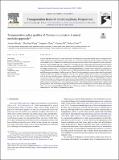Transportation policy profiles of Chinese city clusters: A mixed methods approach
Author(s)
Moody, Joanna Charlotte; Wang, Shenhao; Chun, Jungwoo; Ni, Xuenan; Zhao, Jinhua
DownloadPublished version (542.4Kb)
Publisher with Creative Commons License
Publisher with Creative Commons License
Creative Commons Attribution
Terms of use
Metadata
Show full item recordAbstract
Chinese cities have experienced diverse urbanization and motorization trends that present distinct challenges for municipal transportation policymaking. However, there is no systematic understanding of the unique motorization and urbanization trends of Chinese cities and how physical characteristics map to their transportation policy priorities. We adopt a mixed-method approach to address this knowledge gap. We conduct a time-series clustering of 287 Chinese cities using eight indicators of urbanization and motorization from 2001 to 2014, identifying four distinct city clusters. We compile a policy matrix of 21 policy types from 44 representative cities and conduct a qualitative comparison of transportation policies across the four city clusters. We find clear patterns among policies adopted within city clusters and differences across clusters. Wealthy megacities (Cluster 1) are leveraging their existing urban rail with multimodal integration and transit-oriented development, while more car-oriented wealthy cities (Cluster 2) are building urban rail and discounting public transport. Sprawling, medium-wealth cities (Cluster 3) are opting for electric buses and the poorest, dense cities with low mobility levels (Cluster 4) have policies focused on road-building to connect urban cores to rural areas. Transportation policies among Chinese cities are at least partially reflective of urbanization and motorization trends and policy learning needs to account for these distinct patterns in both physical conditions and policy priorities. Our mixed-method approach (involving time-series clustering and qualitative policy profiling) provides a way for government officials to identify peer cities as role models or collaborators in forming more targeted, context-specific, and visionary transportation policies.
Date issued
2019-09Department
MIT Energy Initiative; Massachusetts Institute of Technology. Department of Urban Studies and PlanningJournal
Transportation Research Interdisciplinary Perspectives
Publisher
Elsevier BV
Citation
Moody, Joanna et al. "Transportation policy profiles of Chinese city clusters: A mixed methods approach." Transportation Research Interdisciplinary Perspectives 2 (September 2019): 100053 © 2019 The Authors
Version: Final published version
ISSN
2590-1982